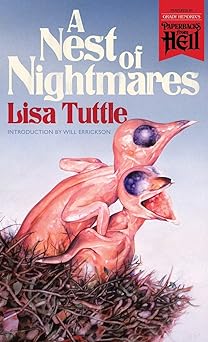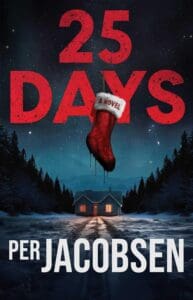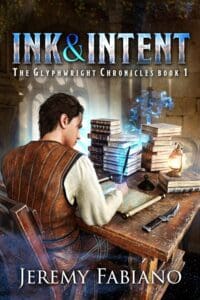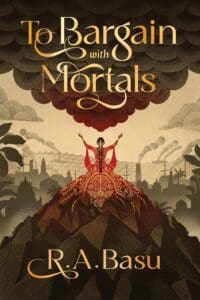
Synopsis:
In Lisa Tuttle’s stories, the everyday domestic world of her female protagonists is invaded by the bizarre, the uncanny, the horrific. In ‘Bug House’, a woman who goes to visit her aunt is shocked to find she is dying – but even more shocking is what is killing her. The divorcing couple in ‘Community Property’ arrive at a macabre solution for how to divide ownership of a beloved pet. In ‘Flying to Byzantium’, a writer traveling to a science fiction convention finds herself caught in a strange and terrifying hell. The thirteen tales in this collection are highly original and extremely chilling, and they reveal Tuttle to be a master of contemporary horror fiction.
Never before published in the United States and highly sought-after by collectors, A Nest of Nightmares (1986) is a classic of modern horror. This new edition features the original paperback cover art by Nick Bantock and a new introduction by Will Errickson.
‘Thirteen stories guaranteed to leave you strongly disquieted’ – Neil Gaiman
Review:
Lisa Tuttle’s “A Nest of Nightmares” is a short story collection so brilliantly eerie and so beautifully chilling, that it almost defies explanation. If you like your domestic horror with a generous dollop of existential dread, Tuttle’s compelling compendium covers all bases.
For those who are unfamiliar with the icon that is Lisa Tuttle, this is the perfect opportunity to acquaint yourself. Tuttle (one of the first feminist horror writers alongside Joyce Carol Oates) had the opportunity to write alongside literary greats in the 70s and 80s, including George R. R Martin and Ramsey Campbell. For some inexplicable reason, Tuttle continues to be criminally underrated.
Originally published in 1986, “A Nest of Nightmares,” is a collection of 13 tales that hasn’t been widely available for decades. Luckily, the wonderful folks over at Valancourt books, with the help of Grady Hendrix and Will Erickson have returned the collection to its former glory, as a part of the Paperbacks from Hell series. As a lover of vintage horror, it warms my black little heart that I can recommend the best of 70s and 80s horror to you wonderful readers, and they’ll be readily available for you to buy and enjoy too.
In this review, I will delve into the depth of my top 3 stories. If you take one short story collection recommendation from me, take this one. The haunting, spine-chillingly clever prose is on par with the work of LaRocca, whilst the stories themselves are unlike anything I have ever read.
Most of these stories feature a strong female protagonist, as is Tuttle’s speciality. Sara, from the short story “The Other Mother,” is a protective and determined matriach, Karen from “Dollburger,” is a strong willed little girl determined to protect her toys from evil, Ellen from “Bughouse,” is a brave woman left to fend for herself in the middle of nowhere… and so on. Whilst it’s impossible to “form connections,” with characters within such a small page count, they were all three-dimensional, flawed, and suited to their story.
“A Nest of Nightmares,” has one of the strongest starts to a short story collection, possibly ever. “Bug House,” is a story that forces the reader to look over their shoulder throughout, and leaves them staring at the wall after. This one comes in at 24 pages, and doesn’t just pack a punch… it packs a sledgehammer to the stomach. Following the shocking realisation that her husband is a cheating dirtbag, Ellen goes to visit her Aunt May. Unsure what to expect, considering she last saw the woman 3 years ago, she arrives at her termite-ridden, dilapidated home- to find something’s very wrong. Disturbingly, Aunt May is utterly convinced she is on the verge of death (beyond your typical old people morbidity) and completely refuses any help that Ellen offers her. Perhaps even more disturbingly, is Peter. Peter is a relatively attractive young man, with a vile demeanour. He delivers Aunt May groceries, and refuses payment for them… what their arrangement is remains a mystery to Ellen.
That’s all I plan to divulge. This story features one of the most intricate, vile, disgusting, heart-breaking metaphors, potentially ever, which is revealed at the ending. The running theme throughout all of these stories is that the endings are mind-blowing. As each story draws to a close, Tuttle consistently throws in an insane plot twist that corrupts the entire meaning- turns it on its head completely- and personally left me stunned. The Bughouse has a particularly grim revelation at the end, which I immediately had to inform my non-bookish (completely unbothered) friends about. Insect horror at its PRIME.
In “Dollburger,” Karen is devastated when she finds her favourite doll Kristina has gone missing. In an attempt to turn this mystery into a learning curve, her father fabricates a story about the “Doll-burger eaters.” Under the cover of darkness, “The Doll-burger eaters,” seek out dolls who have not been tidied away for the night, and steal them away in order to grind them up into burgers. Karen, is determined to not let this happen to her other dolls, so stays awake, in order to keep an ear out for the doll-burger eaters. It turns out that the danger is very real, and not just for the dolls.
This story is 7 pages long, and had possibly the most terrifying ending ever. I hate dolls. I hate bugs. Within the first two stories, we get both. Yay! As a reader, you’re convinced that everything is fine, until in one paragraph, a heart-warming cautionary tale is twisted into the down-right macabre.
Finally, in “Treading the Maze,” Amy and Phil are on a tour of England: climbing mountains, staying in quaint B&Bs and making precious memories. In the town of Glastonbury, the two witness something peculiar from their bedroom window- a figure treading a “Turf maze.” The next morning Phil is eager to explore this, and despite Amy’s inexplicable reluctance, walks the maze. Two years later, following Phil’s tragic death, Amy returns to the same B&B, and is (for some reason) drawn toward the very same maze. The ending is clever, emotional and obviously worth the small page count.
This one is a commentary on grief, fate and time. I have a very niche comparison, for a very niche plot. “A man in your garden,” which can be found in Todd Kiesling’s collection “Ugly Little Things,” has a very similar plot twist. If you liked that, read this (and vice versa).
This review has by no means encapsulated the utter joy that I had whilst reading this collection. I must now read everything Lisa Tuttle has ever written. It is only fair that in turn for the: joy, dread, pain and shock that Tuttle has evoked from me, I humbly offer “A Nest of Nightmares,” a rare 10/10 review. I know, right?
If you revel in finding horror within the everyday, stories that defy explanation, you will love “A Nest of Nightmares,” as much as I did. It’s an absolute must-read, that transcends the boundaries of time, with its contents proving just as fresh and enthralling as they were in 1986. From me, this is more than a recommendation, it is an invitation to embrace the carefully crafted nightmares within this collection, nightmares that will continue to linger in the recesses of your imagination long after you’ve turned the final page.








Leave a Reply